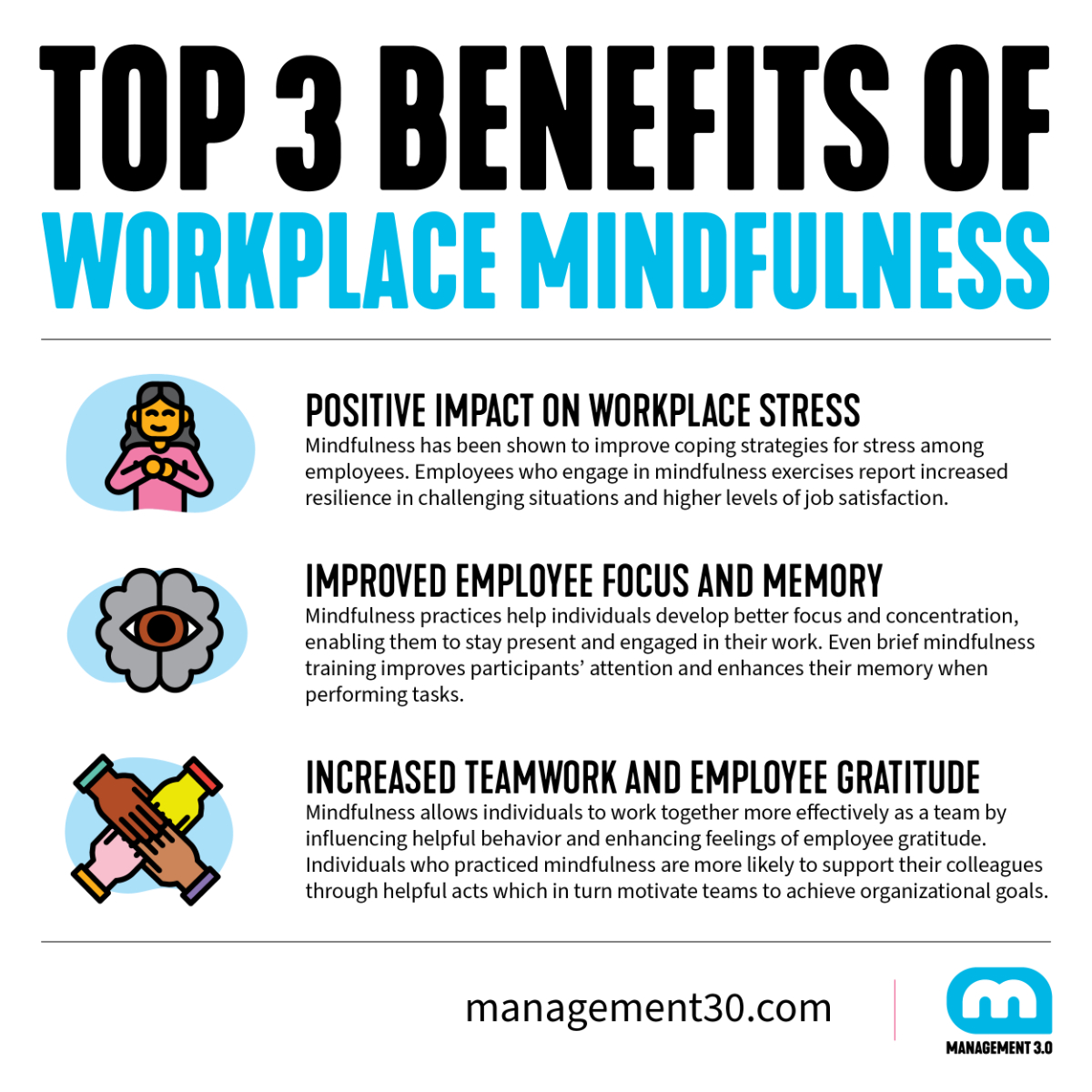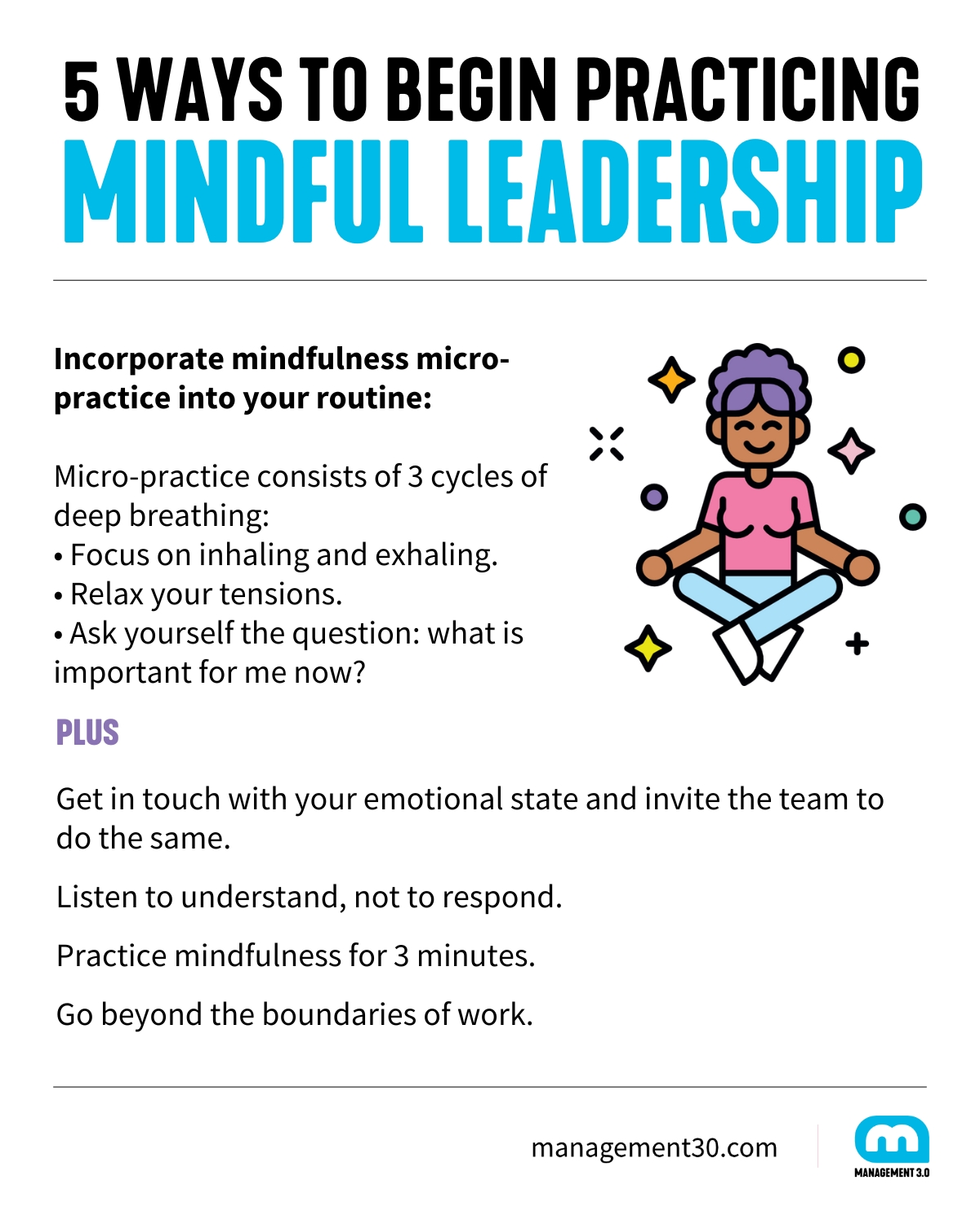Much has been said about mindfulness and increasingly more is being said about mindful leadership, mindfulness in business, or just mindfulness at work. But why is this so relevant, and how can we develop it, if at all? This is a guide on how to be a mindful leader by Management 3.0 Facilitator Thiago Brant.
Quick links:
Mindfulness theory
How mindfulness relates to leadership
Why is mindfulness important in the workplace?
Mindfulness and Employee Engagement
Mindful Leadership Exercises
Mindful Leadership: where to start?
Book Recommendations for Mindful Leaders
With the advent of Agile Leadership, more and more courses and trainings are available on this topic (Agile Leadership, Leading with Agility, Mindfulness Leadership, etc…), and they all address mindfulness and emotional intelligence in leadership. It seems that it will be inevitable for the leader of the future to have to address these issues.
Mindfulness is the awareness that arises by paying attention, mindfully, in the present moment, without judgment.
Jon Kabat-Zinn
A little bit of mindfulness theory
Sustaining present moment awareness: That’s what mindfulness is all about. It’s also referred to as full attention, and has many benefits that have already been researched and is something we can develop and something that can help us gain other skills.
People who develop mindfulness practices become more aware of their inner self and deepen their self-knowledge. You can measure the practice by the changes in the brain. It is like lifting weights to gain muscle mass.
The greater capacity for being present that mindfulness provides, allows one to better observe what is happening and as a result to find more effective responses to what the world presents.
Douglas McGregor’s Theory Y, says that “people want to be the best they can be and contribute to creating value for others (and will do so if they get the right conditions). Author Pía-Maria Thoren adds, that “how we view people affects how we structure our management processes”.
And how can we view people to create the necessary conditions for them to flourish? That’s where agile leadership comes in!

Our minds can become distracted by the urgent at the expense of the important and we can become so preoccupied with yesterday and tomorrow that we are no longer able to excel at leading in the present.
Janice Marturano, founder of The Institute for Mindful Leadership
Mindful Leadership
Author Bill George believes that “if you’re fully present on the job, you will be a more effective leader, you will make better decisions and you will work better with other people”.
Mindful leadership happens as you increase your ability to attune to what is happening in the moment and choose a response, compared to reacting as things happen.
Always start from this reflection:
Your body is present. Is your mind?
The present leader is the one who puts mindfulness into practice in everyday situations and uses the state of presence to help make assertive decisions and to deal with the conflicts and uncertainty of the VUCA (Volatility, Uncertainty, Complexity, and Ambiguity) world.
I once worked in a large corporation that promoted the mantra “Be here now” among its leaders and employees. Be present, make yourself present! This was a reminder to everyone that the present moment, and what is around us, is what really matters in each moment.
How mindfulness relates to leadership
I believe that Zuzanna Ziomecka, a mindfulness teacher, translates how mindfulness relates to leadership in a very complete way when she says that; “These include being fully present, focus, learning to recognize and work within interconnected systems, clarity of perception, steadiness in face of threat or discomfort, the capacity to choose action rather than react automatically, and finally, the capacity for compassionate self-care in the interests of survival.”
We demand increasingly more of our leaders and being present is their greatest weapon to thrive in any scenario.
I recently read an article with Rick Hanson, an expert on positive neuroplasticity, in Forbes Brazil about all the benefits of mindfulness in leadership, and how this practice can be very positive in dealing with the issues we currently struggle with, amid the pandemic and social isolation, and the increase of remote work.
In the article, Rick says that mindfulness is very simple, explaining that we can know ourselves experientially from the inside out, as well as objectively from the outside in. He teaches that the simplest way to experience mindfulness is to breathe three times in a row with full awareness. This takes less than a minute, but it is a challenge to start building the mindfulness muscle. A great benefit the article highlights, is that mindfulness can help us let go of negative emotions we are feeling and research shows that being able to be mindful expands creativity.

Why is mindfulness important in the workplace?
There has been a growing body of research on mindfulness in the workplace over the past decade. Numerous studies have examined the effects of mindfulness interventions, practices, and training programs in work settings. These studies have explored the impact of mindfulness on job satisfaction, stress coping strategies, employee focus and memory, teamwork, and more:
The impact of mindfulness on workplace stress
Mindfulness has been shown to improve coping strategies for stress among employees. A study published in Research in Personnel and Human Resources Management (Glomb, Duffy, Bono, & Yang, 2011) united research which found that employees who engaged in mindfulness exercises reported increased resilience in challenging situations and higher levels of job satisfaction.
How mindfulness can improve employee focus and memory
Mindfulness practices help individuals develop better focus and concentration, enabling them to stay present and engaged in their work. A study conducted at the University of Washington (Levy, Wobbrock, Kaszniak, & Ostergren, 2012) demonstrated that brief mindfulness training improved participants’ attention and enhanced their memory when performing tasks.
The effects of workplace mindfulness on teamwork and employee gratitude
Mindfulness allows individuals to work together more effectively as a team by influencing helpful behavior and enhancing feelings of employee gratitude. A study published in the Journal of Applied Psychology (Sawyer, Thoroughgood, Stillwell, Duffy, et al. 2022) found that individuals who practiced mindfulness were more likely to support their colleagues through helpful acts which in turn motivate teams to achieve organizational goals.

Thelma Bryant-Davis pleads us to “pay attention to your patterns. The way you have learned to survive may not be the way you want to live” and I love how it relates to mindfulness in the workplace. Mindfulness is all about paying attention! Only in a state of presence is it possible to make that observation sincerely.
We can easily apply her advice to organizations:
What we have learned so far, as an organization, that allows us to survive, may not be the way we really want to live.
Observing these patterns and comparing them to the direction of our business values is a constant leadership exercise within organizational environments. And it’s something that helps in two further aspects of McGregor’s Theory Y:
- People need to work and want to take an interest in it. Under the right conditions, they enjoy it
- People will direct themselves towards goals that they accept
Implementing Mindfulness in the Workplace
I believe Marc Lesser’s Seven Practices of a Mindful Leader are a great way to bring mindfulness effectively into our workplace because they are very relevant and aligned with everything we have so far considered. The practices are divided into three parts including:
Part One: Investigate
- Love the work (Theory Y again!):
“Love is the quality of attention we pay to things.” – J. D. McClatchy - Do the work:
“The success of an intervention depends on the inner condition of the intervener.” – Bill O’Brien - Don’t be an expert:
“The Scientific Revolution has not been a revolution of knowledge. It has been above all a revolution of ignorance. The great discovery that launched the Scientific Revolution was the discovery that humans do not know the answers to their most important questions.” – Yuval Noah Harari, Sapiens: A Brief History of Humankind - Connect to your pain:
“There is no coming to consciousness without pain.” -– Carl Jung

Part Two: Connect
- Connect to the pain of others:
“If you want others to be happy, practice compassion. If you want to be happy, practice compassion.” – The Dalai Lama - Depend on others:
“A hundred times every day I remind myself that my inner and outer life are based on the labors of other men, living and dead, and that I must exert myself in order to give in the same measure as I have received and am still receiving.” – Albert Einstein
Part Three: Integrate
- Keep making it simple:
“Traveler, there is no path. You make your own path with each step you take.” – Antonio Machado
Mindfulness and Employee Engagement
In my experience, both as an employee and a leader, and from many conversations with agile and HR leaders I meet in my workshops, I see that the practice of being present in front of people leads to great engagement. Employees greatly value the fact that they are noticed and listened to. Environments with present leaders are much happier and more engaging.
Mindful Leadership Exercises
Two exercises I would suggest, in addition to the seven practices listed earlier, are simple.
Mindful Leadership Exercise #1:
Breathe
Use breathing to be present or to bring you into presence. Stop for a few minutes and breathe consciously.

Mindful Leadership Exercise #2:
Feedback Wrap
Secondly, the Feedback Wrap is a Management 3.0 practice that consists of building your feedback using 5 ingredients, forming a delicious wrap. The second ingredient, “List your observations”, is all about presence!
Separating what is an observation from what are feelings and judgments is a great exercise in presence. This practice, very much in line with nonviolent communication, can help you be a mindful leader!
Mindful Leadership: Where to start?
To make it even easier to put all of this into practice, I asked my fellow Facilitator Fabiana Mello, an expert on the topic, to suggest a simple way to get started with mindfulness techniques for workplace stress reduction. And here is her contribution!
“If you’ve already convinced yourself of the importance of practicing mindfulness in the workplace, take your first steps right now:
- Incorporate mindfulness micro-practice into your routine.
Micro-practice consists of 3 cycles of deep breathing. In the first cycle, focus on inhaling and exhaling, in the second cycle relax your tensions, and in the last cycle ask yourself the question: what is important for me now?
Repeat the micro-practice a few times throughout the day. Suggestions: before a work meeting, whenever you are about to start an activity, in moments when you notice some emotional tension. - Get in touch with your emotional state and invite the team to do the same.
Adopt the practice of checking in at the beginning of each work meeting. Invite each participant to share one word about how they are feeling when they arrive for the meeting. - Listen to understand, not to respond.
Try to listen to the other person with a curious attitude, while trying to understand what is being said. When you realize that you are thinking of a good answer, or an excellent counter-argument to their point, turn your attention to listening instead. - Practice mindfulness for 3 minutes.
Choose a moment in your day to bring attention to your breathing. Start with just 3 minutes! If you can do it at the same time each day, it will help you to keep your rhythm. Maybe you can do this at the beginning of your work day. What do you think? Invite the team to do the same and share your experience. - Go beyond the boundaries of work.
Practice mindfulness outside of the work environment – even while gaining muscle! Choose a physical activity where you need to be mindful of movement: an artistic activity, a dance class, hiking in nature etc.”

Book Recommendations for Mindful Leaders
Some books are must-reads for the agile leader of the future. I was so inspired by these books that much of what I mention in this article comes from them!
- Neurodharma: New Science, Ancient Wisdom, and Seven Practices of the Highest Happiness – Rick Hanson
- Mindfulness for All – Jon Kabat-Zinn
- Nonviolent Communication – Marshall B. Rosenberg
- Focus: The Hidden Driver of Excellence – Daniel Goleman
- Seven Practices of a Mindful Leader – Marc Lesser

Now it’s up to you
I believe that by now you are already convinced of the importance of Mindful Leadership and I hope these insights will help you become a more mindful leader.
As I was reflecting on all that I’ve written, I was reminded of a quote that I often mention as I open Management 3.0 workshops:
“Fortunately, many managers have realized that the greater challenge is working with people, not with machines.”
I think it illustrates the change that took us from Management 1.0 to 2.0. And for 3.0, I see McGregor’s theory further incorporated.
Believe me: the best way to work/deal with people is presence! As a leader, being present is the best thing you can do for the people who work with you.
Header image by Vie Studio (via Pexels)



I like this article a lot as I also teach mindfulness at work. Actually I found so many relations between mindfulness and agility that I founded my business mindfullyagile. Today I finish my great m3.0 training that allows me to apply for a facilitator. If m3.0 would also be interested in offering a training for mindfulness in business, especially to support building new mindsets for agile transitions I would be the first excited person to apply to be a facilitator and teacher for it. Thanks.